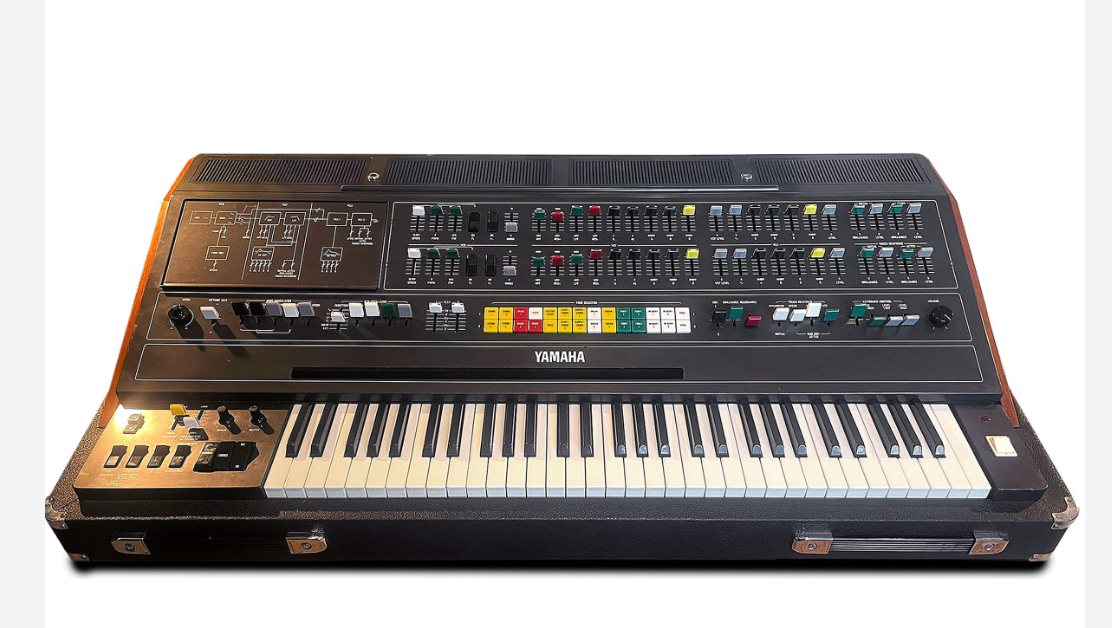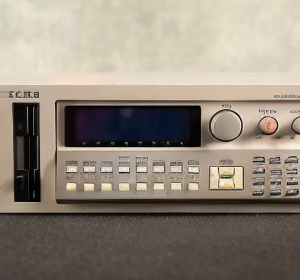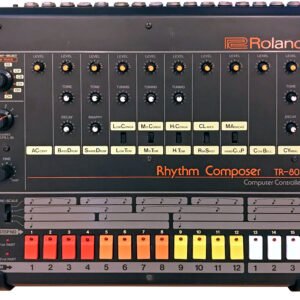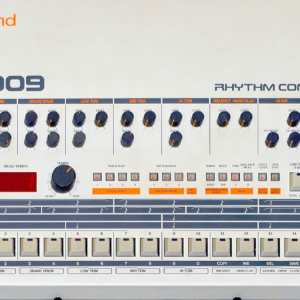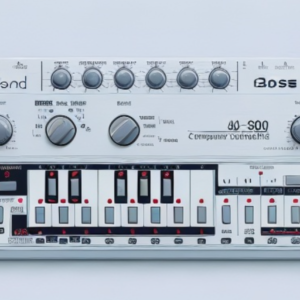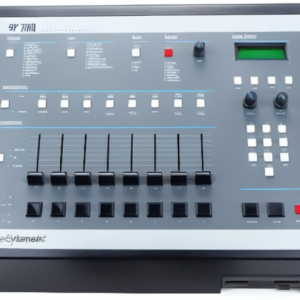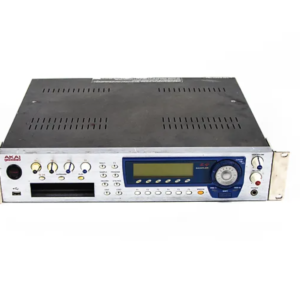Yamaha CS80
The Yamaha CS-80 stands as an iconic synthesizer, revered for its groundbreaking innovation and timeless sound. Introduced in 1977, it quickly earned a reputation among musicians for its unparalleled expressiveness and rich, lush tones. As one of the first polyphonic synthesizers with true voltage-controlled oscillators (VCOs), it marked a significant leap forward in analog synthesis technology.
Designed by the visionary engineer Taro Kakehashi, founder of Roland Corporation, the CS-80 represented a culmination of Yamaha’s expertise in electronic music instruments. Its distinctive sound architecture combined with a sophisticated interface made it a favorite among leading artists of the era, from progressive rock bands to film composers.
At the heart of the CS-80’s sonic capabilities were its dual-layered voice architecture and innovative polyphonic aftertouch keyboard. This allowed for a level of expressiveness previously unheard of in synthesizers. Musicians could achieve dynamic and nuanced performances by controlling parameters such as filter cutoff, resonance, and envelope settings with the pressure applied to the keys after they were depressed.
The CS-80’s sound palette ranged from warm and ethereal to bold and brassy, making it adaptable to a wide variety of musical genres. Its distinctive voice can be heard on countless classic recordings, including those by artists such as Vangelis, Toto, and Jean-Michel Jarre, as well as in film scores like “Blade Runner” by Vangelis and “The Shining” by Wendy Carlos.
Despite its acclaim, the Yamaha CS-80 was produced in relatively limited quantities and was discontinued in 1980, further adding to its mystique and collectibility. Today, it remains highly sought after by synthesizer enthusiasts and musicians alike, cherished for its unique sound and undeniable impact on the history of electronic music.
In this exploration, we delve into the Yamaha CS-80, uncovering its origins, technical innovations, musical legacy, and enduring allure. Join us as we journey through the sonic landscapes shaped by this legendary instrument, celebrating its place in the pantheon of synthesizer history.
Design and Features of the Yamaha CS-80
The Yamaha CS-80 was not only ahead of its time in terms of sound capabilities but also in its design and features, setting a standard for synthesizers that followed. Here’s a closer look at the design philosophy and standout features that made the CS-80 a revolutionary instrument:
Dual-Layered Voice Architecture: One of the defining features of the CS-80 was its dual-layered voice architecture, which allowed for rich and complex sounds. Each voice consisted of two independent synthesizer layers, which could be combined or played separately. This feature provided musicians with a remarkable level of sonic versatility and depth.
Polyphonic Aftertouch Keyboard: The CS-80 featured a groundbreaking keyboard with polyphonic aftertouch, a feature that allowed players to modulate parameters individually for each note played. This level of expressiveness was unprecedented in synthesizers of the time, enabling performers to create dynamic and nuanced performances with subtle variations in pressure applied to the keys.
Analog Signal Path: True to the era of analog synthesis, the CS-80 boasted an all-analog signal path, with voltage-controlled oscillators (VCOs), filters, and amplifiers. This contributed to its warm, organic sound and made it highly desirable among musicians seeking rich, vintage tones.
Semi-Weighted Keys with Wooden Action: The keyboard of the CS-80 featured semi-weighted keys with a wooden action, providing a tactile and responsive playing experience reminiscent of traditional acoustic instruments. This design choice added to the instrument’s premium feel and contributed to its reputation as a high-end performance instrument.
Versatile Sound-Shaping Controls: The CS-80 offered a comprehensive set of sound-shaping controls, including multiple oscillator waveforms, resonant low-pass and high-pass filters, envelope generators, and modulation options. This extensive control set allowed musicians to sculpt a wide range of sounds, from lush pads to piercing leads.
Performance Controls and Preset Memory: In addition to its extensive sound-shaping capabilities, the CS-80 featured performance controls such as pitch bend, modulation wheels, and a ribbon controller for added expressiveness. It also included a limited preset memory, allowing users to store and recall their favorite sounds for live performances or studio sessions.
Built-In Effects: The CS-80 was equipped with built-in effects, including chorus and phaser, which further enhanced its sonic palette and contributed to its iconic sound. These effects could be applied globally or independently to each synthesizer layer, providing even more flexibility in sound design.
Overall, the design and features of the Yamaha CS-80 reflected a commitment to innovation and excellence, establishing it as a landmark instrument in the history of synthesizers. Its combination of advanced technology, expressive control, and rich analog sound continues to captivate musicians and enthusiasts to this day, ensuring its enduring legacy in the world of electronic music.
Sound Generation of the Yamaha CS-80
The Yamaha CS-80’s sound generation capabilities were at the forefront of analog synthesizer technology during its era. Its architecture allowed for the creation of rich, textured sounds with a level of expressiveness that set it apart from its contemporaries. Let’s delve into the key components of its sound generation system:
Voltage-Controlled Oscillators (VCOs): The CS-80 featured two sets of dual VCOs per voice, providing a total of 16 VCOs in the 8-voice polyphonic configuration. These VCOs generated the fundamental waveforms for sound production, including sawtooth, square, pulse, and triangle waves. The ability to mix and detune these oscillators allowed for the creation of thick, detuned, and harmonically rich sounds.
Voltage-Controlled Filters (VCFs): Following the VCOs in the signal path were two resonant voltage-controlled filters per voice. These filters provided the ability to sculpt the harmonic content of the sound by attenuating frequencies above or below a set cutoff point. The CS-80’s filters were renowned for their smooth and musical character, contributing to its warm and lush sonic signature.
Amplifiers and Envelope Generators: Each voice in the CS-80 included dedicated voltage-controlled amplifiers (VCAs) and envelope generators (EGs) for shaping the volume envelope of the sound. The EGs allowed for precise control over parameters such as attack, decay, sustain, and release, enabling the creation of sounds with dynamic articulation and evolving textures.
Polyphonic Aftertouch Keyboard: The CS-80’s keyboard was equipped with polyphonic aftertouch capabilities, allowing performers to modulate parameters such as filter cutoff, resonance, and vibrato depth on a per-note basis. This innovative feature added an unprecedented level of expressiveness to performances, allowing for nuanced and emotive playing techniques.
Modulation Sources and Destinations: The CS-80 offered a range of modulation options, including two LFOs (Low-Frequency Oscillators) and a dedicated modulation generator. These modulation sources could be routed to various destinations within the synthesizer, such as oscillator pitch, filter cutoff, and amplifier level, allowing for the creation of evolving timbres and complex textures.
Performance Controls: In addition to its extensive sound generation capabilities, the CS-80 featured performance controls such as pitch bend, modulation wheels, and a ribbon controller. These controls allowed performers to add expressive gestures to their playing, further enhancing the musicality of the instrument.
Built-In Effects: The CS-80 included built-in effects, such as chorus and phaser, which could be applied to the overall sound or independently to each synthesizer layer. These effects added depth and dimension to the instrument’s sound, further expanding its sonic palette.
In summary, the Yamaha CS-80’s sound generation system combined advanced analog circuitry with innovative design features to create a versatile and expressive instrument capable of producing a wide range of sounds, from lush pads to piercing leads. Its unique combination of technology, craftsmanship, and musicality cemented its place as a legendary synthesizer in the history of electronic music.
Technical Specifications of the Yamaha CS-80
Here are the technical specifications of the Yamaha CS-80, providing an overview of its capabilities and features:
Synthesis Type: Analog subtractive synthesis.
Polyphony: 8 voices (can be split or layered).
Keyboard: 61 keys with polyphonic aftertouch and wooden action.
Oscillators: 2 VCOs per voice, each with sawtooth, square, pulse, and triangle waveforms. Oscillator sync and cross-modulation capabilities.
Filters: 2 resonant voltage-controlled filters (VCFs) per voice, switchable between low-pass and high-pass modes. Cutoff frequency, resonance, and keyboard tracking controls.
Envelopes: 2 envelope generators (EGs) per voice, with adjustable attack, decay, sustain, and release parameters.
Modulation: 2 Low-Frequency Oscillators (LFOs) with multiple waveform options (sine, triangle, sawtooth, square). Dedicated modulation generator with multiple destinations.
Performance Controls: Pitch bend wheel, modulation wheel, ribbon controller.
Effects: Built-in chorus and phaser effects with adjustable parameters.
Memory: Limited preset memory for storing and recalling sounds.
Connectivity: Audio outputs (main and sub), external control inputs (CV/Gate), expression pedal input.
Dimensions: Approximately 1140 mm (W) x 545 mm (D) x 165 mm (H).
Weight: Approximately 85 kg (187 lbs).
Power: AC 100V, 120V, 220V, or 240V (switchable), 150 watts.
Manufacturing Period: Produced from 1977 to 1980.
Availability: Relatively limited production quantities, making it a sought-after vintage instrument.
The Yamaha CS-80’s technical specifications highlight its advanced analog synthesis capabilities, expressive keyboard, and versatile sound-shaping controls. Its distinctive features, such as polyphonic aftertouch and dual-layered voice architecture, set it apart as a pioneering instrument in the world of synthesizers. Despite being discontinued decades ago, the CS-80 remains highly coveted by musicians and collectors for its unique sound and iconic status in electronic music history.
Performance and Workflow with the Yamaha CS-80
The Yamaha CS-80 offered a unique performance experience and workflow that distinguished it from other synthesizers of its time. Its expressive keyboard, versatile sound-shaping controls, and innovative features made it a favorite among musicians seeking a dynamic and immersive playing experience. Let’s explore how performers interacted with the CS-80 and its workflow:
Expressive Keyboard: The CS-80’s 61-key keyboard was renowned for its polyphonic aftertouch capabilities, allowing performers to modulate parameters such as filter cutoff, resonance, and vibrato depth on a per-note basis. This feature enabled musicians to infuse their performances with nuance and emotion, adding depth and expressiveness to their playing.
Dynamic Sound Shaping: With its dual-layered voice architecture and extensive sound-shaping controls, the CS-80 offered a wide range of sonic possibilities. Performers could create rich, evolving textures by manipulating parameters such as oscillator waveform, filter cutoff, resonance, envelope settings, and modulation sources. This versatility allowed for the creation of lush pads, soaring leads, and complex soundscapes.
Performance Controls: The CS-80 was equipped with dedicated performance controls, including pitch bend and modulation wheels, as well as a ribbon controller. These controls provided additional avenues for expression and creativity, allowing performers to add dynamic gestures and effects to their playing in real-time.
Live Sound Manipulation: During live performances, musicians could manipulate the CS-80’s parameters in real-time to shape the sound and create unique sonic textures. The instrument’s tactile controls and responsive interface facilitated intuitive exploration and experimentation, empowering performers to engage with their audience and captivate listeners with expressive performances.
Layering and Splitting Sounds: The CS-80’s dual-layered voice architecture allowed performers to layer or split sounds across the keyboard, creating rich and complex textures. This feature enabled the creation of multi-layered sounds with different timbres and articulations, enhancing the instrument’s versatility and musicality.
Built-in Effects: The CS-80 included built-in chorus and phaser effects, which could be applied globally or independently to each synthesizer layer. These effects added depth and dimension to the instrument’s sound, further enhancing its expressiveness and musicality.
Limited Preset Memory: While the CS-80 offered a limited preset memory for storing and recalling sounds, many performers preferred to create sounds from scratch during live performances or studio sessions. This hands-on approach encouraged exploration and experimentation, allowing musicians to craft unique sounds tailored to their artistic vision.
In summary, the Yamaha CS-80 offered a performance and workflow experience characterized by its expressive keyboard, dynamic sound shaping capabilities, and intuitive controls. Whether on stage or in the studio, musicians could unleash their creativity and push the boundaries of sonic expression with this legendary synthesizer.
Notable Users and Influences of the Yamaha CS-80
The Yamaha CS-80’s distinctive sound and expressive capabilities have left an indelible mark on the world of music, influencing a wide range of artists across various genres. Here are some notable users and the ways in which the CS-80 has influenced their work:
Vangelis: Perhaps one of the most iconic users of the CS-80, Vangelis utilized the synthesizer extensively in his groundbreaking film scores, including “Blade Runner,” “Chariots of Fire,” and “1492: Conquest of Paradise.” The CS-80’s lush pads, haunting leads, and expressive capabilities played a pivotal role in shaping the atmospheric soundscapes for which Vangelis is renowned.
Toto: The American rock band Toto incorporated the CS-80 into their studio recordings, notably using it for its warm, analog textures in songs like “Africa” and “Rosanna.” The CS-80’s rich sound and expressive keyboard added depth and character to Toto’s music, contributing to their distinctive sound.
Jean-Michel Jarre: The electronic music pioneer Jean-Michel Jarre utilized the CS-80 in many of his seminal works, including albums such as “Oxygène” and “Equinoxe.” Jarre’s use of the CS-80’s expansive sound palette and expressive capabilities helped define the sonic landscape of electronic music in the 1970s and beyond.
Stevie Wonder: Stevie Wonder incorporated the CS-80 into his recordings during the late 1970s and early 1980s, using its lush pads and dynamic keyboard to add depth and emotion to his music. The CS-80’s expressive capabilities complemented Wonder’s soulful vocals and virtuosic keyboard playing, contributing to the timeless appeal of his songs.
Wendy Carlos: Wendy Carlos, known for her pioneering work in electronic music and film scoring, utilized the CS-80 in her compositions, including the score for Stanley Kubrick’s film “The Shining.” The CS-80’s rich, cinematic sound contributed to the atmospheric and haunting quality of Carlos’ music, helping to create immersive sonic landscapes.
Sting: The CS-80 made appearances in recordings by Sting, particularly during his time with The Police. Its warm, analog tones added depth and texture to songs like “Every Breath You Take,” contributing to the band’s distinctive sound.
Film and Television Scores: Beyond individual artists, the Yamaha CS-80 has left an enduring mark on film and television scores. Its lush, cinematic sound has been featured in numerous soundtracks, contributing to the immersive and emotive quality of the music.
In summary, the Yamaha CS-80’s influence extends across a diverse range of musical genres and artistic endeavors. Its distinctive sound and expressive capabilities have shaped the work of countless artists and composers, leaving an indelible legacy in the world of music.
Impact and Legacy of the Yamaha CS-80
The Yamaha CS-80’s impact and legacy in the realm of electronic music are profound, shaping the course of musical innovation and inspiring generations of musicians, composers, and synthesizer enthusiasts. Here’s a closer look at its enduring influence:
Pioneering Sound: The CS-80’s rich, warm analog sound and expressive capabilities established it as a benchmark for synthesizer technology. Its dual-layered voice architecture, polyphonic aftertouch keyboard, and versatile sound-shaping controls set a new standard for sonic depth and expressiveness in electronic instruments.
Musical Innovation: The CS-80 played a pivotal role in the evolution of electronic music, providing musicians with a powerful tool for sonic exploration and experimentation. Its influence can be heard across a diverse range of musical genres, from progressive rock and jazz fusion to electronic, ambient, and film music.
Iconic Performances: Countless iconic performances and recordings have been shaped by the CS-80’s distinctive sound and expressive capabilities. Artists such as Vangelis, Toto, Jean-Michel Jarre, and Stevie Wonder incorporated the CS-80 into their music, contributing to its legendary status in the annals of music history.
Cinematic Soundscapes: The CS-80’s lush, cinematic sound has left an indelible mark on the world of film and television scoring. Its haunting pads, ethereal leads, and dynamic keyboard have been featured in numerous soundtracks, helping to create immersive and emotive sonic landscapes in films such as “Blade Runner” and “The Shining.”
Collectibility and Rarity: Due to its relatively limited production quantities and cult following, the CS-80 has become highly sought after by synthesizer enthusiasts and collectors. Its rarity and iconic status have elevated it to legendary status in the world of vintage synthesizers, with well-preserved units commanding high prices on the second-hand market.
Inspiration for Future Generations: The CS-80 continues to inspire musicians, composers, and synthesizer designers to this day. Its innovative features, timeless sound, and enduring legacy serve as a source of inspiration for artists seeking to push the boundaries of electronic music and create new sonic landscapes.
In summary, the Yamaha CS-80’s impact and legacy in the world of electronic music are undeniable. As a pioneering instrument that pushed the boundaries of analog synthesis, it remains a symbol of innovation, creativity, and sonic exploration, ensuring its revered status among musicians and enthusiasts for generations to come.
Collector's Value and Market Trends
The collector’s value and market trends surrounding the Yamaha CS-80 reflect its iconic status and enduring popularity among synthesizer enthusiasts and musicians. Here’s a closer look at its collector’s value and market trends:
High Collector’s Value: The Yamaha CS-80 is highly sought after by collectors due to its rarity, historical significance, and distinctive sound. Well-preserved units in good working condition can command premium prices on the second-hand market, often reaching several thousand dollars or more.
Limited Production Numbers: The CS-80 was produced in relatively limited quantities during its production run from 1977 to 1980. This scarcity has contributed to its collector’s value, as fewer units are available compared to other synthesizers from the same era.
Vintage Synthesizer Market: The vintage synthesizer market has experienced significant growth in recent years, driven by increasing interest from collectors, musicians, and enthusiasts. Iconic instruments like the CS-80 have become highly sought after, with prices rising accordingly.
Condition and Maintenance: The condition of a CS-80 significantly influences its collector’s value. Units that have been well-maintained, serviced, and restored to original condition typically command higher prices. Factors such as cosmetic wear, functional issues, and the availability of spare parts can also impact value.
Historical Significance: The CS-80’s historical significance as one of the first polyphonic synthesizers with true voltage-controlled oscillators (VCOs) adds to its collector’s value. Its role in shaping the sound of iconic recordings and its association with renowned artists further enhance its appeal among collectors.
Demand from Musicians and Producers: Beyond collectors, there is also demand for the CS-80 among musicians, producers, and composers seeking its distinctive sound and expressive capabilities. This demand contributes to its market value and ensures a steady stream of interest in the instrument.
Availability and Accessibility: While the CS-80 is highly coveted, its limited availability and high price point can make it inaccessible to some enthusiasts. As a result, alternative options such as software emulations or sample libraries have emerged to provide a more accessible means of capturing its sound.
In summary, the Yamaha CS-80’s collector’s value and market trends reflect its status as a legendary synthesizer with enduring appeal. Its scarcity, historical significance, and iconic sound continue to captivate collectors and musicians alike, ensuring its place as a prized possession in the world of vintage synthesizers.
Innovations and Contributions
The Yamaha CS-80 introduced several innovations and made significant contributions to the field of synthesizer technology and electronic music. Here are some of its key innovations and contributions:
Polyphonic Aftertouch: The CS-80 was one of the first synthesizers to feature polyphonic aftertouch, allowing performers to modulate parameters such as filter cutoff and vibrato depth on a per-note basis. This innovation greatly enhanced expressiveness and enabled nuanced and dynamic performances.
Dual-Layered Voice Architecture: The CS-80’s dual-layered voice architecture allowed for the creation of complex sounds by layering two independent synthesizer voices. This feature provided musicians with a wide range of sonic possibilities and contributed to the instrument’s versatility.
Expressive Keyboard: Equipped with a 61-key keyboard featuring wooden action and polyphonic aftertouch, the CS-80 offered a highly expressive playing experience. Performers could add subtle nuances and articulations to their performances using the keyboard’s responsive touch sensitivity.
Analog Signal Path: The CS-80 employed an all-analog signal path, including voltage-controlled oscillators (VCOs), filters, and amplifiers. This resulted in a rich, warm sound characteristic of vintage analog synthesizers and contributed to the instrument’s distinctive sonic character.
Versatile Sound-Shaping Controls: With a comprehensive set of sound-shaping controls including multiple oscillator waveforms, resonant filters, envelope generators, and modulation options, the CS-80 provided musicians with extensive creative possibilities for sculpting and shaping sounds.
Built-In Effects: The CS-80 featured built-in chorus and phaser effects, enhancing its sonic palette and adding depth and dimension to its sound. These effects could be applied globally or independently to each synthesizer layer, further expanding the instrument’s sonic capabilities.
Influence on Music Production: The CS-80’s lush, cinematic sound and expressive capabilities left a lasting impact on music production, particularly in film and television scoring. Its distinctive timbres can be heard in numerous soundtracks, contributing to the immersive and emotive quality of the music.
Inspiration for Future Designs: The CS-80’s innovative features and expressive capabilities have influenced the design of subsequent synthesizers and electronic instruments. Its polyphonic aftertouch keyboard, in particular, has been replicated in various modern synthesizer designs, demonstrating its enduring legacy in the field of electronic music technology.
Overall, the Yamaha CS-80’s innovations and contributions have played a significant role in shaping the landscape of synthesizer technology and electronic music. Its expressive capabilities, rich sound palette, and versatile design continue to inspire musicians and designers to push the boundaries of sonic exploration and creativity.
Conclusion
In conclusion, the Yamaha CS-80 stands as a landmark instrument in the history of synthesizers, renowned for its groundbreaking innovations, distinctive sound, and enduring legacy. From its introduction in 1977 to its discontinuation in 1980, the CS-80 pushed the boundaries of analog synthesis technology and set new standards for expressiveness and versatility.
With its pioneering features such as polyphonic aftertouch, dual-layered voice architecture, and expressive keyboard, the CS-80 offered musicians unprecedented control over sound and performance. Its rich, warm analog tones, coupled with built-in effects and extensive sound-shaping capabilities, made it a favorite among leading artists and composers across a wide range of musical genres.
The CS-80’s influence extends beyond its role as a musical instrument; it has left an indelible mark on the world of electronic music production and sound design. Its distinctive sound can be heard in countless recordings, film scores, and live performances, shaping the sonic landscape of popular music and cinema.
As a collector’s item, the CS-80 remains highly coveted, with well-preserved units commanding premium prices on the second-hand market. Its rarity, historical significance, and iconic status ensure its enduring appeal among synthesizer enthusiasts and musicians alike.
Innovation, creativity, and sonic exploration are at the heart of the Yamaha CS-80’s legacy. Its contributions to electronic music technology and its impact on musical expression continue to resonate with artists and enthusiasts, ensuring its place as a timeless icon in the world of synthesizers.
